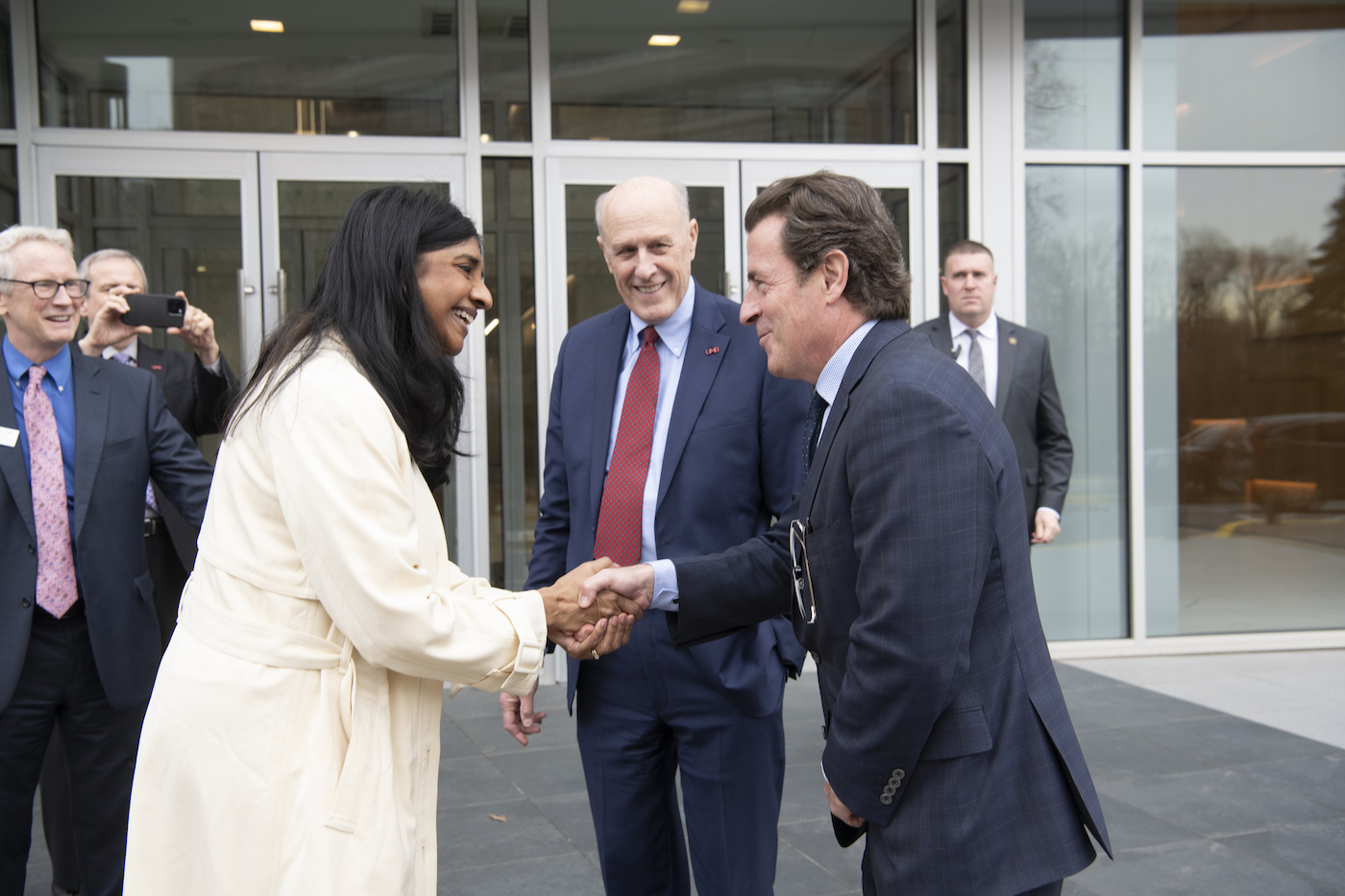UM Institute for Health Computing Up and Running
March 13, 2024 Alex Likowski
The strategic initiative aims to improve the health and well-being of those living in Maryland and beyond using advanced computing tools like artificial intelligence and machine learning.
Photo: Lt. Gov. Aruna Miller shakes hands with School of Medicine Dean Mark T. Gladwin, MD, as UMB President Bruce E. Jarrell, MD, FACS, looks on. Photo by Matthew D'Agostino
“This is really, really exciting,” Maryland Lt. Gov. Aruna Miller told a gathering of 50 scientists and policy leaders at the University of Maryland Institute for Health Computing (UM-IHC) in North Bethesda on March 8. “Please know that this state is a partner with every one of you. Whatever we can do, to be able to succeed here in Montgomery County means we succeed over the entire state of Maryland.”
The UM-IHC is a strategic initiative that aims to improve the health and well-being of those living in Maryland and beyond using advanced computing tools like artificial intelligence, machine learning, and network medicine to create a premier learning health care system. It merges top-tier computational expertise and biomedical research with a vast clinical care network that is diverse socioeconomically and geographically. This network includes access to clinical trial data and de-identified electronic health records from 2 million patients in the University of Maryland Medical System.
“We see this as the East Coast Silicon Valley for health computing,” University of Maryland School of Medicine (UMSOM) Dean Mark T. Gladwin, MD, explained. The center’s location also brings significant benefits, he added. “Why here? We’re on the Red Line. Montgomery County has more than 320 companies. We’re here by NIH, FDA, multiple biomedical partners, and research facilities. We’re by IBBR [Institute for Bioscience and Biotechnology Research], USG [Universities at Shady Grove]. And again, we're a triangle between UMB, College Park, and this incredible, vibrant location. So, we're looking to build the economy through partnerships, and the development of new commercial entities in the space of artificial intelligence.”
The institute’s staff has only very recently moved into its new headquarters. The team has already generated results from its first analyses and anticipates scaling up its analytical operation in the next two months, which will be fueled by the activation of the institute’s high-performance computing center.
The 10-year sublease comprises more than 27,000 square feet of state-of-the-art technology and office space, which will serve as IHC’s home until a planned $200 million facility is completed at the North Bethesda Metro Station.
Both UM-IHC’s current temporary and future locations include space for federal science partners to improve collaboration within the bioscience community.
“The FDA has already signed a memorandum of understanding with us and they are looking forward to expanding the machine learning and AI group in very close partnership with the Institute for Health Computing,” explained Amitabh Varshney, PhD, dean of the College of Computer, Mathematical, and Natural Sciences at the University of Maryland, College Park (UMCP). “So, we see this as a partnership that reinvigorates and revitalizes the fantastic opportunities between the federal government, industry, and the universities right here in Montgomery County and in the state of Maryland.”
Gladwin noted that UM-IHC has already received its first of what are expected to be many grants to perform medical studies. Rozalina McCoy, MD, MS, associate professor of medicine at UMSOM, will use big datasets to determine if new weight-loss drugs are as effective or more effective than bariatric surgery.
“Every step we take is looking to advance clinical outcomes, particularly focusing on health equity,” said Bradley A. Maron, MD, professor of medicine at UMSOM and co-director of the UM-IHC.